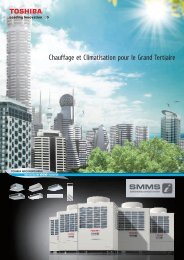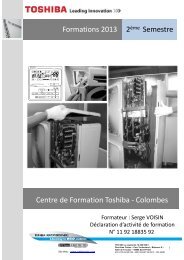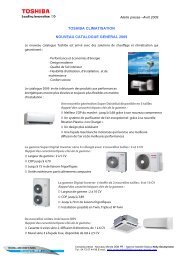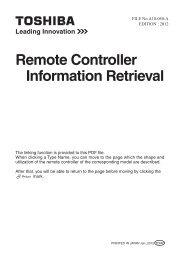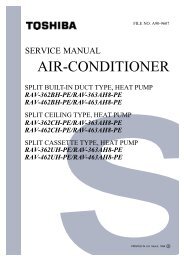Super Multi System - Toshiba
Super Multi System - Toshiba
Super Multi System - Toshiba
Create successful ePaper yourself
Turn your PDF publications into a flip-book with our unique Google optimized e-Paper software.
64<br />
Control features<br />
Outdoor unit/<strong>Multi</strong> Controller<br />
No. Control Description<br />
4 Simultaneous<br />
cooling/heating<br />
a. Changeover between cooling and heating operations for each indoor unit.<br />
operation The solenoid valves inside the <strong>Multi</strong> Controller are energised when operation<br />
commands are sent from the indoor units.<br />
SVS valve (suction side) opens for a cooling command.<br />
SVD valve (discharge side) opens for a heating command.<br />
b. Determination of the outdoor unit operation mode and frequency of the<br />
compressor.<br />
These are determined by the difference between the total requested cooling<br />
command frequencies and the total requested heating command frequencies<br />
of all Indoor units.<br />
c. Outdoor unit refrigerant control during cooling dominant mode.<br />
Refrigerant flow is controlled by PMV2. The degree of opening is<br />
controlled by the difference of all requested cooling and heating command<br />
frequencies and the compressor operation frequency.<br />
This flow control is required to divide cooling exhaust heat appropriately<br />
between indoor units in heating mode and the outdoor unit heat exchanger.<br />
High pressure control is performed to ensure that the capacity of the<br />
indoor units in heating is maintained. This is controlled by the outdoor<br />
unit fan control and the changeover from the main heat exchanger to the<br />
sub heat exchanger.<br />
d. Outdoor unit refrigerant control during heating dominant mode.<br />
<strong>Super</strong>heat control is performed by the outdoor unit expansion valve.<br />
Evaporating temperature control is performed by the outdoor unit fan<br />
control to ensure that the capacity of the Indoor units in cooling mode is<br />
maintained.<br />
Changeover from expansion valve to capillary control is performed<br />
when there is a minimal difference between the cooling and heating<br />
demands and the heat absorption of the outdoor unit heat exchanger is low.



